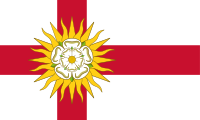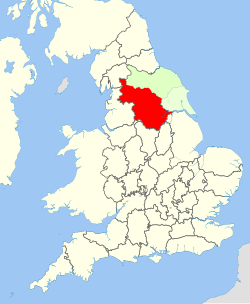West Riding of Yorkshire
 From Wikipedia - Reading time: 10 min
From Wikipedia - Reading time: 10 min
| County of York, West Riding | |
|---|---|
 Flag of West Riding (2013) | |
 1888–1974: County of York in England: West Riding (red), North Riding (light green), and East Riding (very pale green) | |
| Area | |
| • 1911 | 1,685,409 acres (6,820.61 km2) |
| • 1961 | 1,621,068 acres (6,560.23 km2) |
| Population | |
| • 1901 | 1,538,572 |
| History | |
| • Created |
|
| • Abolished |
|
| • Succeeded by | |
| Status | Ancient riding, then administrative county |
| Chapman code | WRY |
| Government | |
| • HQ | Wakefield |
| • Motto | Audi consilium (Heed counsel)[1] |
 Coat of arms of West Riding County Council | |
The West Riding of Yorkshire was one of three historic subdivisions of Yorkshire, England. From 1889 to 1974 the riding was an administrative county named County of York, West Riding. The lieutenancy at that time included the city of York and as such was named "West Riding of the County of York and the County of the City of York".[2] The riding ceased to be used for administrative purposes in 1974, when England's local government was reformed.
Contemporary local government boundaries in Yorkshire largely do not follow those of the riding. All of South Yorkshire (except Finningley) and West Yorkshire were historically within its boundaries, as were the south-western areas of North Yorkshire (including Ripon), the Sedbergh area of Cumbria, the Barnoldswick and Slaidburn areas of Lancashire, the Saddleworth area of Greater Manchester and the part of the East Riding of Yorkshire around Goole and southwest of the River Ouse.
Geography
[edit]The West Riding encompassed 1,771,562 acres (7,169 km2) from Sheffield in the south to Sedbergh in the north and from Dunsop Bridge in the west to Adlingfleet in the east.
The southern industrial district, considered in the broadest application of the term, extended northward from Sheffield to Skipton and eastward from Sheffield to Doncaster, covering less than one-half of the riding. Within this district were Barnsley, Batley, Bradford, Brighouse, Dewsbury, Doncaster, Halifax, Huddersfield, Keighley, Leeds, Morley, Ossett, Pontefract, Pudsey, Rotherham, Sheffield, Todmorden (partly in Lancashire until 1888, when fully incorporated into Yorkshire) and Wakefield. Major centres elsewhere in the riding included Harrogate and Ripon.
Within the industrial region, other urban districts included Bingley, Bolton on Dearne, Castleford, Cleckheaton, Elland, Featherstone, Handsworth, Hoyland Nether, Liversedge, Mexborough, Mirfield, Normanton, Rawmarsh, Rothwell, Saddleworth, Shipley, Skipton, Sowerby Bridge, Stanley, Swinton, Thornhill, Wath-upon-Dearne, Wombwell and Worsborough. Outside the industrial region were Goole, Ilkley, Knaresborough, Otley and Selby. The West Riding also contained a large rural area to the north including part of the Yorkshire Dales National Park (the remainder of the park being in the North Riding).
History
[edit]The subdivision of Yorkshire into three ridings or "thirds" (Old Norse: Þriðungr) is of Scandinavian origin. The West Riding was first recorded (in the form West Treding) in the Domesday Book of 1086.[3]
Unlike most English counties, Yorkshire, being so large, was divided first into the three ridings (East, North and West) and, later, the city of York (which lay within the city walls and was not part of any riding). Each riding was then divided into wapentakes, a division comparable to the hundreds of southern and western England and the wards of England's four northernmost historic counties.
Administrative county
[edit]
The administrative county was formed in 1889 by the Local Government Act 1888, and covered the historic West Riding except for the larger urban areas, which were county boroughs with the powers of both a municipal borough and a county council. Initially there were five in number: Bradford, Leeds, Huddersfield, Halifax, and Sheffield. The City of York (also a county borough) was included in the county for census and lieutenancy purposes. The number of county boroughs increased over the years; Rotherham gained this status in 1902, Barnsley and Dewsbury in 1913, Wakefield in 1915 and Doncaster in 1927. The boundaries of existing county boroughs were also widened.
Beginning in 1898, the West Riding County Council was based at the County Hall in Wakefield, which was inherited by the West Yorkshire Metropolitan County Council in 1974.[4]
The Local Government Act 1888 included the entirety of Todmorden with the West Riding administrative county, and also in its lieutenancy area ("county"), though the postal address for Todmorden was Lancashire. Other boundary changes in the county included the expansion of the county borough of Sheffield southward in areas historically in Derbyshire such as Dore.
Fingerposts erected in the West Riding until the mid-1960s had a distinctive style. At the top of the post was a roundel in the form of a hollow circle with a horizontal line across the middle, displaying "Yorks W.R.", the name of the fingerpost's location, and a grid reference. Other counties, apart from Dorset,[5] did not display a grid reference and did not have a horizontal bar through the roundel. From 1964, many fingerposts were replaced by ones in the modern style, but some of the old style still survive within the West Riding boundaries.
By 1971 1,924,853 people (or 50.85% of the West Riding's population) lived in the administrative county, against 1,860,435 (or 49.15%) in the ten county boroughs.
Divisions
[edit]Ancient riding
[edit]Earlier
[edit]In the Domesday Book of 1086 they were eleven wapentakes, these were as follows:[6]
| Domesday name | Later name | Also known as/ division names | Other status post-Domesday | |
|---|---|---|---|---|
| Agbrigg | Agbrigg and Morley (temporarily) | |||
| Morley | Blackston Edge, Bradfordale or Sowerbyshire | |||
| Ainsty | Ainsty of York | Joined the City of York outside the Riding system in the 15th century | ||
| Barkston | Barkston Ash | Jointly known as Elmet | ||
| Skyrack | Skyrack Upper | Airedale | ||
| Skyrack Lower | ||||
| Burghshire (of Aldborough) | Claro Upper | Wharfedale, Nidderdale, of Knaresborough, Riponshire or Kirbyshire | Liberty and Honour | |
| Claro Lower | ||||
| Strafforth | Strafforth and Tickhill Upper | of Mexborough, of Tickhill, Hallam or Hallamshire | Liberty or Honour | |
| Strafforth or Tickhill Lower | ||||
| Craven/ Cravenshire | Staincliffe West | Ribblesdale or Bowland | Temporarily merged into Staincliffe and Ewecross | Honour |
| Staincliffe East | Staincliffe, of Skipton or Craven | |||
| Ewecross | ||||
| Osgoldcross | Marshland | Liberty | ||
| Staincross | ||||
Later
[edit]
In the end of regular use, the wapentakes were:
- Ewcross
- Staincliffe West
- Staincliffe East
- Claro Lower
- Strafforth and Tickhill Lower
- Morley
- Skyrack Upper
- Claro Upper
- Skyrack Lower
- Barkston Ash
- Agbrigg
- Staincross
- Osgoldcross
- Strafforth and Tickhill Upper
Riding as a county
[edit]During the West Riding's time as a county; rural districts, Urban districts and municipal boroughs were under the administrative county while county boroughs were in the wider geographic county.
Current usage
[edit]
The term "West Riding" continues to be used by organisations based in the historic area of the riding, such as the West Riding Sailing Club,[7] the Ramblers,[8] the West Riding County Football Association, and the Freemasons.[9] It is also retained in the name of some British Army squadrons, such as the 106 (West Riding) Field Squadron,[10] and some historical re-enactment groups.[11][12] A flag designed to represent the West Riding was registered with the Flag Institute charity in 2013.[13]
See also
[edit]- List of Lords Lieutenant of the West Riding
- Custos Rotulorum of the West Riding of Yorkshire – List of Keepers of the Rolls
References
[edit]- ^ "Civic Heraldry of England and Wales - Yorkshire, West Riding (Obsolete)". Civicheraldry.co.uk.
- ^ Lewis, Samuel A topographical dictionary of England (Vol. IV, p. 618) S. Lewis & Co., London: 1831.
- ^ Smith, A. H. (1962). The Place-names of the West Riding of Yorkshire. Vol. 7. Cambridge University Press. pp. 117–118.
- ^ New Municipal Buildings at Wakefield, The Times, 23 February 1898.
- ^ Viner, D. 2007 Discover Dorset: Roads, Tracks and Turnpikes Wimborne: The Dovecote Press, p.68
- ^ "West Riding of Yorkshire". Retrieved 1 February 2024.
- ^ "West Riding Sailing Club | Yorkshire | England". Wrsc.org.uk.
- ^ "Home". Ramblersyorkshire.org.
- ^ "Masonic Province of Yorkshire, West Riding". Archived from the original on 11 February 2010. Retrieved 11 February 2013.
- ^ "Army Reserve Units | Sheffield Greenhill". Army. Retrieved 27 December 2023.
- ^ "His Majesty's 33rd Regiment of Foot". 33rdfoot.co.uk.
- ^ "51stlight.co.uk". Archived from the original on 4 March 2016. Retrieved 11 February 2013.
- ^ "Yorkshire – West Riding". Flag Institute. Retrieved 13 March 2015.
External links
[edit] Media related to West Riding of Yorkshire at Wikimedia Commons
Media related to West Riding of Yorkshire at Wikimedia Commons- Map of the West Riding of Yorkshire on Wikishire
- Information on the West Riding of Yorkshire on I'm From Yorkshire
 KSF
KSF
